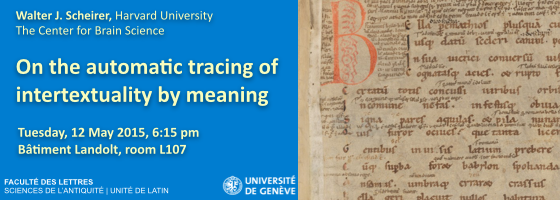On the automatic tracing of intertextuality by meaning

Walter J. Scheirer, Harvard University, The Center for Brain Science
On the automatic tracing of intertextuality by meaning
In literary study, intertextuality refers to the reuse of text, where new meaning or novel stylistic effects have been generated. Most typically in the digital humanities, algorithms for intertextual analysis search for approximate lexical correspondence that can be described as paraphrase. This talk introduces a complimentary approach that more closely captures the behavior of the reader when faced with meaningful connections between texts in the absence of words that have the same form or stem, which constrains the match to semantics. The technique employed for identifying such semantic intertextuality is the popular natural language processing strategy of semantic analysis. Unlike the typical scenario for semantic analysis, where a corpus of long form documents is available, the far more limited textual fragments that embody intertextuality are examined. In classical studies, we are primarily concerned with texts from antiquity, where small phrases or passages often form the locus of comparison. In this vein, this talk describes a specific case study of established parallels between book 1 of Lucan’s Civil War and all of Vergil’s Aeneid. Applying semantic analysis over these texts, it is possible to recover parallels that lexical matching cannot, as well as discover new and interesting thematic matches between the two works. To emphasize the general nature of the approach, a second case study that explores the intertextual nature of emerging English language literatures on the Internet will also be discussed.
Mardi 12 mai 2015 à 18h15
Bâtiment Landolt, salle L107
5 mai 2015